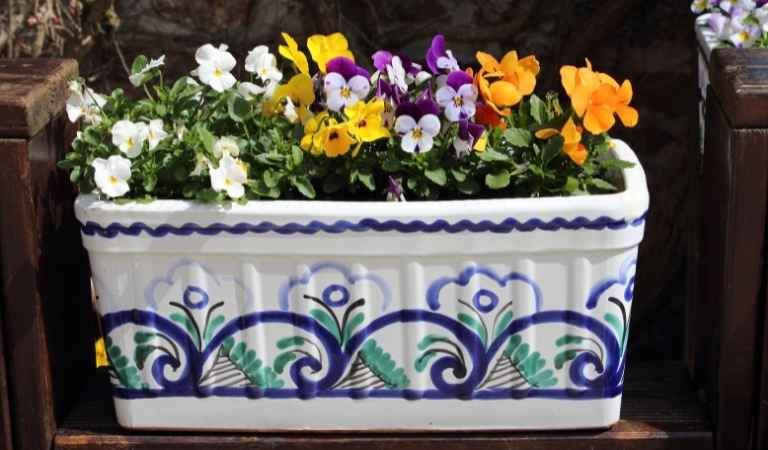It’s a pretty common misconception that acrylic paint will kill plants. But, it is not the case unless you do it the wrong way.
Acrylic paint is water-based and can be used on most surfaces without causing harm to any living creature or plant life. It does not contain harmful chemicals that could cause damage to vegetation or other organisms in your garden such as insects, birds, and small mammals.
In fact, many people use this type of product for their gardens because it has no negative effects on anything but what is being painted!
If you are still worried about using acrylics around your garden then take a look at some of these facts: they are non-toxic; they have little to no odor; they dry quickly so there is no time for them to cause damage; they clean up easily and can be used over again.
What makes acrylic paints different from other types is that it contains a small amount of ammonia which gives plants the ability to become more resistant to pests and diseases.
However, there are things that you need to understand regarding the paint on plants. We’ll share with you everything, in detail!

Is Acrylic Paint Harmful to Plants?
No, acrylic paints are not harmful or toxic to plants. It is a myth that the paints kill them. Such thoughts are not based on any scientific proof and have no base in reality.
Acrylics don’t contain harmful chemicals, so they won’t hurt your garden in any way!
However, you should still take some precautions before using it anywhere near your plants. You need to make sure that it is not labeled as hazardous or toxic, the paint is from a reputed manufacturer and has no harmful chemicals in it.
You should never use acrylic paints near the crops intended for human consumption as well so that there remains no risk of contamination.
How Can Acrylic Paint Harm Plants?
The reason why some people say that acrylic paint harms plants is because of the ammonia in it. If you are using this type of paint to cover a wooden surface in your garden, the ammonia might react with stainless steel nails or screws.
This can cause corrosion and lead to the formation of rust on them. These nails may not harm your plants but you should remove them before letting any moisture accumulate anywhere near them which could cause rust stains.
This will prevent your plants from growing near the rusty nails and damage their roots. Plus, some acrylic paints come with toxic additives that may kill your plants if you apply paint near the plants.
Acrylic paint is water-soluble which can cause the paint to wash away from surrounding surfaces and gather in your garden in heavy rain. This is another that can cause damage to your plants.
So, if you want to use acrylic paints in your garden, make sure it is plant-safe paint with no toxic chemicals added.
Can I Paint Plants with Acrylic?
No, you can’t paint the plants with acrylic. It is not a good idea to use any type of paints on garden plants because they usually prevent the plant from carrying out photosynthesis.
When plants take in photosynthesis, the chlorophyll which is a green pigment absorbs light in order to create organic compounds that are required for plant development. Acrylic paint will prevent this process from happening because it acts as a barrier to sunlight and other light waves. This will reduce the number of leaves, flowers, and fruits produced by your plants. It could also kill the plant because of the lack of sunlight.
That’s why we recommend not using any type of paint on plants directly. If you want to make your garden look better and more aesthetic, use your creative mind to safely paint the planters.
Our Top 2 Plant Safe Spray Paint Recommendations
Many were asking if there is any non-toxic spray paint that can safely transform plants and grass. Although there are some that are safe to apply on real plants or grass directly, the color choice you get is extremely limited. Here are our top recommendations-
1. Seymour 20-602 Grass and Shrub Renew
This is a fast-drying marking paint that covers up brown spots while still allowing the existing foliage to grow. Will not harm plant or grass; does not wash away with rain or irrigation.
The Seymour Grass and Shrub Renew marks your hard surfaces with a crisp, clean coat of dark green U.V protective paint for year-round home maintenance so you can enjoy the view without needing to dig in the garden every weekend! Just one application of this easy-to-use acrylic coating will make any yard pop!
2. Lawnlift Ultra Concentrated (Green) Grass Paint
Who needs to pull weeds, cut grass, and worry about fertilizing when you can just paint your green lawn a few times a year? Lawnlift Ultra Concentrated Grass Paint is non-toxic and lasts for up to 90 days at a time. Get the picture?
This is safe for pets, too! Turn your yard into an oasis in less than an hour with this fantastic product that is both artistic and versatile…Also features resistant formula for those heavy rainfalls or excessive watering schedules.
Can I spray paint flower pots?
Yes, you can. The type of paint does not matter as much as the quality of it. Be sure to use one that has a good reputation for adhesion and durability.

Many new paints have come out in recent years with claims that they are “green” or environmentally safe. In many cases, these paints will be no safer than any other paint. It is important to know the toxicity levels and if you use a paint that is not labeled as non-toxic be sure to wash it off your plants after they have been painted and avoid contact with the foliage while painting.
What kind of paint to use on outdoor planters?
Acrylic paint is the best type of paint to use on outdoor planters. Other types of paints that are safe for outdoor planters include latex, enamel, and oil-based paints. The key with all these different types of paints is to make sure they’re waterproof or contain a sealant so that it doesn’t get washed away in rain or snow.

Plus, as I said earlier, you need to make sure the paint doesn’t get into the plant directly. A good way to do this is to put a layer of newspaper, plastic, or cardboard between the plant and the planter when applying paint.
If you really want to make sure all the paint stays out of your plants, then go with something like concrete or slate for the planter itself. These types of materials are good because they don’t absorb any toxic materials like many other commonly used materials do.
Any other tips for caring for outdoor planters?
Once you’ve painted the outdoor planter, make sure to spray it with sealant or protect it from the weather. This will help keep out moisture and prevent rust. Personally, I use a clear acrylic spray like Krylon Clear Acrylic Coating Aerosol because it both seals and protects at the same time.
The plant itself is another important aspect of caring for outdoor planters. If you’re going to be growing plants in your planter, make sure to choose durable plants that can withstand the elements and aren’t overly sensitive to chemicals and paints.
Plus, avoid disposing of acrylic paints in your garden, as they can seep into your soil and contaminate it.
Can you paint plastic plant pots with acrylic paint?
You can paint plastic plant pots with acrylic paint, but be aware that acrylic doesn’t stick to plastic well. We have an article on applying acrylic paint to plastic and the risks of using it. You can read that for a detailed answer.


